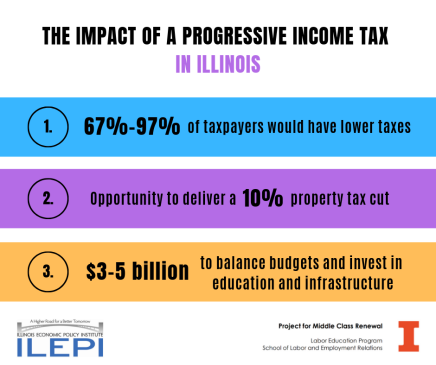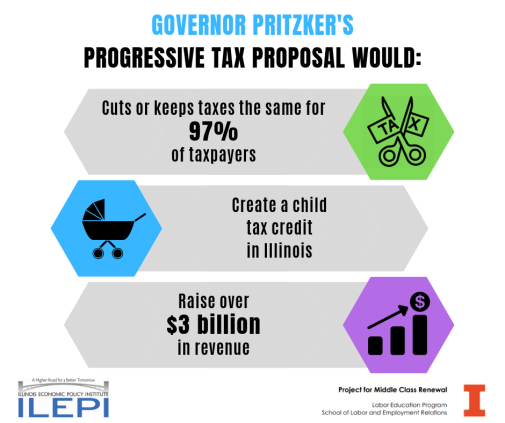The Illinois Economic Policy Institute and the University of Illinois at Urbana-Champaign have jointly released a one-page fact sheet on the impacts of switching to a progressive income tax in Illinois.
Governor J.B. Pritzker and the General Assembly have debated whether to amend the Illinois Constitution to allow the state to replace its flat-rate income tax system with a progressive (or “graduated-rate”) income tax. Illinois is currently one of only 8 states that has a flat tax, while 33 states have progressive tax systems.
There are five main reasons for Illinois to consider adopting a progressive income tax.
- A tax system based on ability to pay: In Illinois, the top 1 percent of families brings in 65 times as much as the average income of the bottom 99 percent. Meanwhile, Illinois has an uncompetitive tax system for middle-class families.
- Tax cuts for working-class and middle-class families: Middle-class families currently pay a greater share of their income in taxes than wealthy households, causing inequality to be worse after taxes are collected.
- The opportunity for property tax relief: At an average of over $5,200 per year, Illinois’ property taxes are among the highest in the nation.
- Raise revenue: Illinois faces $10 billion in unpaid bills, $130 billion in pension liabilities, and a $1.2 billion structural deficit per year that have caused lawmakers to underinvest in core public services.
- Boost the economy: Progressive taxes put more money in the pockets of middle-class families while raising taxes on the wealthy to pay for public investments in education, infrastructure, and healthcare.

A 2019 analysis by the Project for Middle Class Renewal at the University of Illinois at Urbana-Champaign and the Illinois Economic Policy Institute reveals that a progressive tax could accomplish five policy goals.
- Illinois could cut income taxes for 67%-97% of taxpayers while raising taxes on the wealthy.
- Illinois could provide the revenue necessary for the state to boost K-12 public education funding by $2.5 billion, allowing local governments to deliver a 10% property tax cut for homeowners.
- Illinois could cap the tax rate on pass-through business income at 5 percent, protecting small businesses.
- Illinois could eliminate the $1.2 billion structural deficit and restore investor confidence.
- Illinois could grow the state economy by between $1 billion and $8 billion per year.

The “Fair Tax for Illinois” would provide tax relief while allowing the state to boost public investments.
- The Governor’s proposal would either cut taxes or keep them the same for 97% of taxpayers.
- The Governor’s proposal would increase the property tax credit from 5% to 6%, resulting in lower income taxes for all Illinois homeowners.
- The Governor’s proposal would introduce a child tax credit for working-class and middle-class families.
- The Governor’s proposal would increase General Fund revenues by $3 billion per year.

A progressive income tax would transform Illinois’ tax code by bringing middle-class tax burdens down towards rates in neighboring states. Moving to a graduated-rate structure could cut income taxes for the majority of Illinois families, provide opportunities for property tax relief, help balance the budget, and provide revenue to fund essential services that contribute to the growth of the Illinois economy.
Read the full report, The Impact of Enacting a Progressive Income Tax in Illinois: Understanding How Illinois Could Cut Middle-Class Taxes, Balance the Budget, and Grow the Economy, here.
View this blog in PDF form, here.
Cover picture from Flickr User, Chris Potter (2012). Creative Commons User, Attribution 2.0 Generic (CC BY 2.0). Rights to ccPixs.com.
